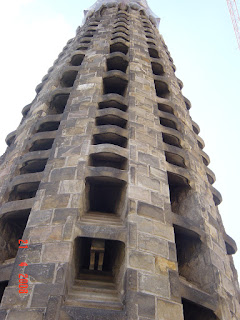I have heard of Gaudi many times. In fact he was mentioned in my university engineering studies as the master of hyperbolic structures. I found it hard to take his work seriously since the photographs of his work that I have seen have always left me a little cold – they felt to me as if they were naïve in the extreme and were better placed as the set from a Disney production of Snow White rather than as examples of serious architecture.
 My first view of the Sagrada Familia in Barcelona did little to change my impression of his work. As I approached nearer and nearer to the Sagrada Familia I could feel myself becoming more and more enamoured of the structure.
My first view of the Sagrada Familia in Barcelona did little to change my impression of his work. As I approached nearer and nearer to the Sagrada Familia I could feel myself becoming more and more enamoured of the structure.When one encounters special historical structures it is difficult not to be overcome by a sense of wonder about, and admiration for, our forefathers. This is particularly the case for me when I encounter a historical monument or a historical religious building that demands to be admired for its purpose, for the magnitude of the commitment that it represents and for the majesty of the architectural achievement that it displays. To my complete surprise I found the Sagrada Familia to be such a historical monument in the making and one that our great grandchildren will admire for its “magnitude of commitment of their forefathers and its majesty of architectural achievement”





Begun as a community project in late 1880’s the Sagrada Familia (or Temple of the Holy Family) is a Cathedral for the City of Barcelona and is on the physical scale of the larger of the other great Christian cathedrals of the world. It is just over 50% complete and continues to be funded by donation and more lately by tourist entry subscriptions. While it is unmistakably a cathedral its architecture and architectural consistency is just extraordinary. It is a work of architectural art with amazing attention to detail.

The design is progressing to the original design of the architect Gaudi preserved in the form of his plaster scale models of the structure. Gaudi had dedicated his life to the building realising very early on that he would be unable to see the structure complete in his lifetime and as a consequence he spent a great amount of time describing his vision for the building in extraordinary detail.
He was held in so much respect that there has been a commitment by his followers to faithfully follow his designs though to completion.
 The tour of a building under construction is an achievement in itself. It is managed in style by the Barcelonans. Even in its construction phase I simply could not feel anything other than a sense of amazement at what is being achieved – I felt for the first time in my life I think that I was actually seeing the creation of a real historical icon rather experiencing a moment in time when history flashed by me.
The tour of a building under construction is an achievement in itself. It is managed in style by the Barcelonans. Even in its construction phase I simply could not feel anything other than a sense of amazement at what is being achieved – I felt for the first time in my life I think that I was actually seeing the creation of a real historical icon rather experiencing a moment in time when history flashed by me.
 The tour of a building under construction is an achievement in itself. It is managed in style by the Barcelonans. Even in its construction phase I simply could not feel anything other than a sense of amazement at what is being achieved – I felt for the first time in my life I think that I was actually seeing the creation of a real historical icon rather experiencing a moment in time when history flashed by me.
The tour of a building under construction is an achievement in itself. It is managed in style by the Barcelonans. Even in its construction phase I simply could not feel anything other than a sense of amazement at what is being achieved – I felt for the first time in my life I think that I was actually seeing the creation of a real historical icon rather experiencing a moment in time when history flashed by me.








